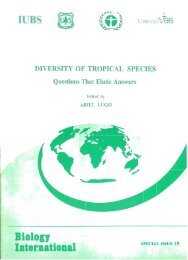SPECIAL ISSUE 34a.pdf - Biology International
SPECIAL ISSUE 34a.pdf - Biology International
SPECIAL ISSUE 34a.pdf - Biology International
You also want an ePaper? Increase the reach of your titles
YUMPU automatically turns print PDFs into web optimized ePapers that Google loves.
<strong>Biology</strong> <strong>International</strong>, Special Issue No. 34 ( 1 997)<br />
Divergence Between the Codes<br />
To anyone familiar only with the botanical Code, the zoological Code does not<br />
at first make easy reading; 1 am certain that the sarne is true for someone<br />
familiar with the zoological Code on being first presented with the ICBN. The<br />
reason for this is much more fundamental than the superficialities of format, or<br />
even the general past practice of the ICZN, fortunately being discontinued, to<br />
use hypothetical rather than actual examples (so that the mythical genera A-us<br />
and B-us appeared confùsingly often). It is indeed a function of the independent<br />
development of the two sets of rules since the "Strickland Rules" (Strickland et<br />
al., 1843), from which zoological nomenclature originated, and de Candolle's<br />
Lois (Candolle, 1867) fiom which the successive editions of the botanical Code<br />
have sternrned. Separate philosophies, manifest in different concepts and ter-<br />
minology, have developed from the same basic principles. This paper seeks to<br />
interpret these differences, distinguishing the superficial fiom the more fùnda-<br />
mental.<br />
By comparison with the ICZN, the Bacteriological Code is an "easy read" for<br />
anyone familiar with the ICBN, doubtless reflecting the fact that, prior to the<br />
BCs development, the botanical Code had governed the nomenclature of<br />
bacteria. Indeed the two Codes are essentially similar apart fiom the BCs<br />
distinctive features of Approved Lists, and the requirement, for establishment of<br />
names, of publication directly or through Validation Lists in the <strong>International</strong><br />
Journal of Systematic Bacteriology. The other differences are the adoption of a<br />
few terms from the zoological Code (see Greuter et al., 1996, Table 1; McNeill,<br />
1996b, Table 2), and the preservation of some elements of earlier editions of the<br />
botanical Code that have been modified in the ICBN since 1978 - i.e. the<br />
bacteriological and botanical Codes are already diverging after only 20 years of<br />
separate existence!<br />
In the discussion that follows, emphasis will be on the differences between the<br />
ICBN and the ICZN with supplemental notes on the provisions of the<br />
Bacteriological Code where these are particularly noteworthy.<br />
The divergence between the botanical and zoological Codes which is, as noted<br />
above, by far the greatest, can be looked on in under six different headings, as<br />
follows:<br />
a. Terminology<br />
b. Form of names and author citation<br />
c. Coverage (up to farnilylall scientific names)<br />
d. Particular requirements and procedures (language requirements; startingpoint<br />
dates; typification procedures; tautonyms; other requirements for<br />
establishment, e.g. basionym citation)<br />
e. Provision for over-riding or supplementing the Code (lists of protected<br />
narnes; registration as a criterion for establishment of names; conservation1<br />
suppression) .<br />
f. Concepts (independency; CO-ordinate status; secondary homonymy;<br />
illegitimacy)




